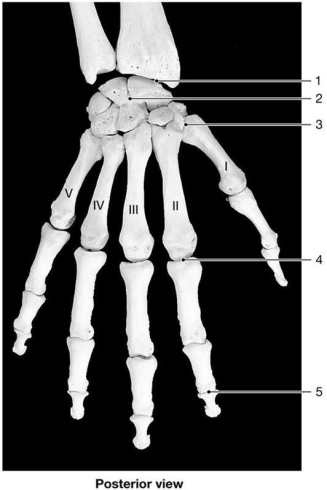A) slick.
B) flat.
C) smooth.
D) rough.
E) both slick and smooth.
G) A) and E)
Correct Answer

verified
Correct Answer
verified
Multiple Choice
Which of the following athletes are at greatest risk of developing a rotator cuff injury?
A) tennis players
B) soccer players
C) runners
D) baseball pitchers
E) high jumpers
G) B) and D)
Correct Answer

verified
Correct Answer
verified
Multiple Choice
In nursemaids elbow the radial head is dislocated from the
A) ulnar collateral ligament.
B) radial collateral ligament.
C) articular capsule.
D) anular ligament.
E) antebrachial interosseous membrane.
G) B) and E)
Correct Answer

verified
Correct Answer
verified
Multiple Choice
A freely movable joint is a(n)
A) synarthrosis.
B) diarthrosis.
C) amphiarthrosis.
D) syndesmosis.
E) symphysis.
G) A) and C)
Correct Answer

verified
Correct Answer
verified
Multiple Choice
The structures that assist the bursae in reducing friction between the patella and other tissues are the
A) fat pads.
B) medial menisci.
C) lateral menisci.
D) popliteal ligaments.
E) cruciate ligaments.
G) C) and D)
Correct Answer

verified
Correct Answer
verified
Multiple Choice
Figure 9-2 Bones of the Wrist and Hand
 Use Figure 9-2 to answer the following questions:
-Identify the type of joint at label "2."
Use Figure 9-2 to answer the following questions:
-Identify the type of joint at label "2."
A) hinge
B) condylar
C) gliding
D) saddle
E) pivot
G) None of the above
Correct Answer

verified
Correct Answer
verified
Multiple Choice
The largest and strongest articulation at the elbow is the
A) humero-ulnar joint.
B) ulnar joint.
C) ulnaradial joint.
D) radial joint.
E) humeroradial joint.
G) None of the above
Correct Answer

verified
Correct Answer
verified
Multiple Choice
Arthritis always involves damage to the ________ cartilages, but the specific cause can vary.
A) articular
B) intervertebral
C) costal
D) elastic
E) fibrous
G) A) and C)
Correct Answer

verified
Correct Answer
verified
Multiple Choice
Identify the incorrect pair.
A) synarthrosis; immovable joint
B) amphiarthrosis; slightly movable joint
C) chondrosis; freely moving joint
D) gomphosis; articulation between tooth and bone
E) They are all correct; there is no incorrect pair.
G) A) and D)
Correct Answer

verified
Correct Answer
verified
Multiple Choice
Identify the incorrect pair.
A) gliding joint; sacroiliac joint
B) pivot joint; hip joint
C) hinge joint; ankle joint
D) condylar joint; radiocarpal joint
E) saddle joint; first carpometacarpal joint
G) C) and D)
Correct Answer

verified
Correct Answer
verified
Multiple Choice
Joints can be classified structurally as
A) bony.
B) fibrous.
C) cartilaginous.
D) synovial.
E) All of the answers are correct.
G) None of the above
Correct Answer

verified
Correct Answer
verified
Multiple Choice
In a triaxial articulation,
A) movement can occur in all three axes.
B) movement can occur in only two axes.
C) movement can occur in only one axis.
D) only circumduction is possible.
E) no movement is possible.
G) C) and D)
Correct Answer

verified
Correct Answer
verified
Multiple Choice
The interspinous ligament is
A) a paired ligament that connects the laminae of adjacent vertebrae.
B) a fibrous band that connects the posterior surfaces of adjacent vertebral bodies.
C) a band of fibrous tissue connecting the spinous processes of adjacent vertebrae.
D) a longitudinal fibrous band that is attached to the tips of spinous processes from C7 to the sacrum.
E) a wide fibrous band that connect the anterior surfaces of the adjacent vertebral bodies.
G) A) and C)
Correct Answer

verified
Correct Answer
verified
Multiple Choice
The movement of rotating a limb outward is called ________ rotation.
A) lateral
B) internal
C) medial
D) superficial
E) abductive
G) C) and E)
Correct Answer

verified
Correct Answer
verified
Multiple Choice
The ligaments that limit the anterior-posterior movement of the tibia and maintain the alignment of thefemoral and tibial condyles are the ________ ligaments.
A) cruciate
B) fibular collateral
C) patellar
D) popliteal
E) tibial collateral
G) B) and C)
Correct Answer

verified
Correct Answer
verified
Multiple Choice
________ is a type of angular movement that decreases the angle between articulating bones.
A) Adduction
B) Abduction
C) Flexion
D) Extension
E) Rotation
G) B) and C)
Correct Answer

verified
Correct Answer
verified
Multiple Choice
Contraction of the muscle that is attached to the radial tuberosity results in
A) flexion of the forearm.
B) extension of the forearm.
C) abduction of the forearm.
D) adduction of the forearm.
E) rotation of the shoulder.
G) A) and B)
Correct Answer

verified
Correct Answer
verified
Multiple Choice
The shoulder joint, or ________ joint, permits the greatest range of motion of any joint.
A) coracocondylar
B) humeroacromial
C) clavicoscapular
D) glenohumeral
E) deltobrachial
G) All of the above
Correct Answer

verified
Correct Answer
verified
Multiple Choice
Bursae are found in all of the following areas except
A) tendon sheaths.
B) beneath the skin covering a bone.
C) within connective tissue exposed to friction or pressure.
D) around blood vessels.
E) around many synovial joints.
G) A) and B)
Correct Answer

verified
Correct Answer
verified
Multiple Choice
Which of the following movements is a good example of abduction?
A) opening the mouth
B) turning the hand palm upward
C) extreme bending of the head backwards
D) moving the hand toward the shoulder
E) spreading the fingers
G) None of the above
Correct Answer

verified
Correct Answer
verified
Showing 81 - 100 of 134
Related Exams